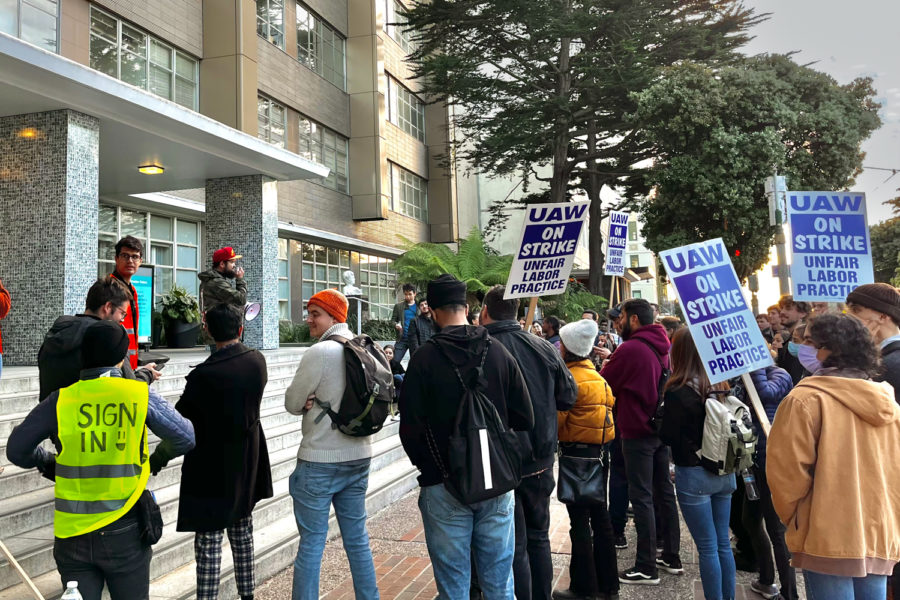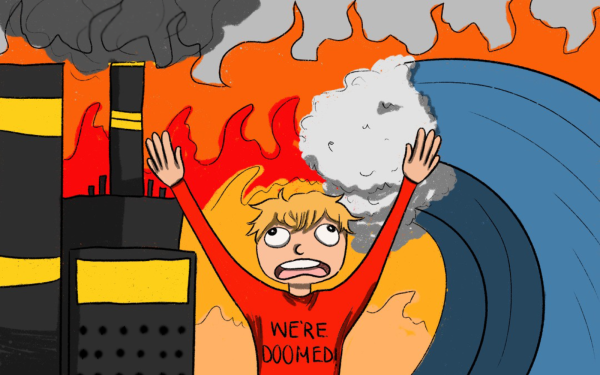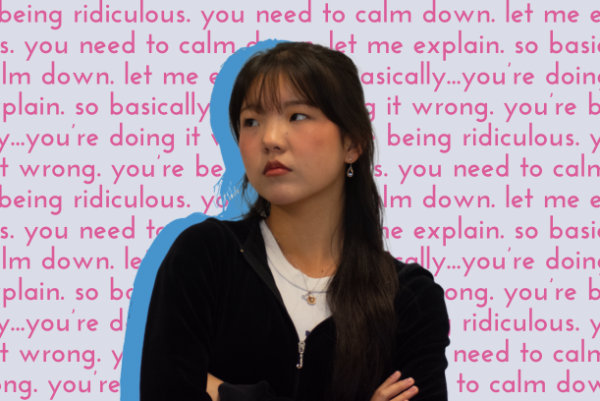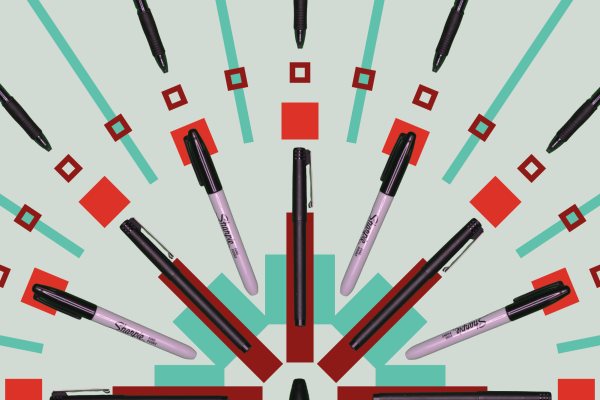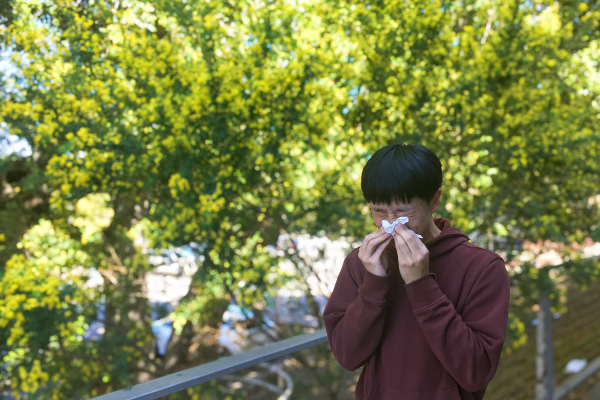A national labor movement: The journey towards better working conditions
Ready for action: The crowd of protesters in front of the UCSF Sol Silverman Oral Medicine Clinic listen to speakers after marching in organized groups while holding signs with “Honk 4 Living Wages” and “On Strike: Unfair Labor Practice.” It is their fourth day outside, and the speaker empowers the crowd to bring more pots, pans, or anything else that makes noise to the upcoming rallies.
January 27, 2023
“What do we want?” a protester yells. The sound of their megaphone pierces through the cold November air.
“Living wages!” the crowd of 50 cries back.
“When do we want them?”
“Now!”
The shout reverberates—a blaring reminder of the urgency of their message.
Chants like these echo down the block like drums as people from the United Automobile Workers labor union (UAW) march along the sidewalks of the University of California, San Francisco (UCSF) campus on Nov. 17, 2022. Every other beat, they raise their signs in the air, pumping their fists.
They are loud, they are inspired, and they are impossible to ignore.
The first time they gathered, just four days prior, the crowd was 800 strong. And the day before, at the Mission Bay campus, 700 people were determined to make a stand.
These protests occurred at every University of California (UC) institution.
Strength in numbers: United Automobile Workers and UCSF
Despite what the name suggests, the UAW protest consists of graduate students, academic researchers, teacher’s assistants, and postdoctoral scholars on strike because of the low pay they receive from UC institutions. UAW is representing them in their battle against the UC system for higher wages.
Strikes like these have become increasingly frequent in most industries as workers rise up to demand better wages and working conditions in a growing nationwide movement of workers learning to value their labor. One way workers can boost their working conditions is by organizing into a labor union.
According to the U.S. Department of Labor, a labor or trade union is a group of employees within a certain industry or company that come together to work towards better treatment of its workers. Unions often ask members to pay dues to fund their operations. They work to negotiate with employers for higher pay, better working conditions, and benefits such as healthcare and paid vacation for their members.
Rhea Misra is a graduate student and student researcher at UCSF who participated in the UAW protest on the sidewalks in front of her campus.
Like the many other protests across California, the UAW protest Misra took part in demanded higher salaries in response to the high living and housing costs of California. Many claimed they were being paid below a living wage—a term used to describe the theoretical minimum income level needed for a worker to afford their basic needs including food, housing, and other necessities, according to Investopedia.
“The UC works because we work. They wouldn’t be able to generate billions of dollars in profits without us. We’re here to not only change the way academia works but to revolutionize the way work is done and show that power is in the people that make the system run,” Misra said.
In addition to demonstrating the power of workers, Misra said the workers were on strike to make themselves heard by the UC, which has not been respecting their demands until now.
“Our union called the strike because the UC hasn’t been negotiating with us in good faith. A lot of us have been bargaining with the UC for over a year, but they’ve been canceling meetings last minute and not even showing up, so we want the UC to know that we are serious about our demands. That’s why we’re out here,” Misra said.
For the UCSF students, the bargaining process is crucial for guaranteeing them benefits.
“We came up with proposals to negotiate with the UC for wages, child care, transit, and accessibility. We’re also negotiating the rules of the contract for workers, so if the contract gets broken, we have a way to enforce it and hold the UC accountable,” Misra said.
Even if the shouts of the UAW protesters are all that people can hear along the blocks in front of UCSF, efforts for a similar cause are heard further into the city.
The butterfly effect: Starbucks Workers United
Just a 10-minute drive away, the Starbucks employees on 18th St. in San Francisco held a strike of their own on the same day.
For employees like James Kreiss, who has been the shift supervisor at the Starbucks location for three years, it’s been a long day of striking. Kreiss is a member of Starbucks Workers United, a union focused on the Starbucks coffee chain boasting over 250 unionized stores and 21,000 supporters, according to its website.
From 6 a.m. to 6 p.m., Kreiss and other employees stood outside their store with food, drinks, music, and signs, interacting with pedestrians passing by.
Although it’s their third year working at the location, Kreiss has worked for Starbucks for four years.
Standing outside of their closed store, Kreiss and others waved bright red signs with “No contract, no coffee” in bold lettering to demand negotiations with Starbucks.
“Starbucks is not negotiating with us. They’re doing this huge union-busting campaign. We provided them with everything we needed, but we’re still waiting on them to give us a date to start our bargaining. This is true for most of these other union stores—and there are over 240,” Kreiss said.
But for the few stores that do get to bargain, according to Kreiss, their voices are still disregarded.
“When employees go, they show up fully prepared and ready to bargain. Starbucks has a team of lawyers that show up for five minutes and then dip. They don’t even hear us out,” Kreiss said.
At Kreiss’ location, the stories of other Starbucks employees like them inspired their strike.
“We first heard about unionizing when the store in Buffalo, New York unionized their store about a year ago. We started talking about it then, but we didn’t start our process here until we had a five-month shutdown. That was our trigger to be like, ‘This is not okay.’ We weren’t supported by management and we needed to be able to speak up for ourselves,” Kreiss said.
After the shutdown, Kreiss and their group began to reach out to the rest of their store.
“We filed to have an election in May and held that election in August and won. Now we’re waiting to bargain over a contract with Starbucks,” Kreiss said.
Not all locations successfully unionize, however.
As many kids do, Ella Clark dreamed of being president when she grew up. Now, a senior at Tamalpais High School, Clark has got a lot on her plate. She remains interested in politics and is the president of the Model United Nations and Junior State of America clubs at her school. Clark also volunteers to help underserved youth in her spare time.
Additionally, like many other teenagers, she got a job at the Strawberry Village Starbucks in her city, Mill Valley, because she needed to make some money. She chose Starbucks because she agreed with its mission.
“Starbucks preaches a lot of sustainability. There is this program, Grounds for Your Garden, where instead of throwing out our grounds, allegedly, we package them up and give them out to customers for their gardens to use as fertilizer. I also like how employees are called partners, so I really did and still do align with Starbucks’s mission. That’s why I chose to work at Starbucks,” Clark said.
Like Kreiss, Clark heard about the store in Buffalo that had unionized as well as the union-busting campaign that came afterward and became interested in joining the movement in 2021. She eventually reached out to the organizers in Buffalo and they encouraged her to unionize.
“I said, ‘Well, we don’t really have any reasons to at the moment. I’m not upset with my job, I love my job very much.’ The Buffalo organizers explained that you don’t have to hate your job to want to unionize and you don’t have to hate the company that you work for to unionize. And then the more that I went into the process, the more issues I saw at Starbucks,” Clark said.
Clark got on a call with some of the lead organizers in Buffalo who walked her through the unionizing process.
“I reached out to my work friend and talked to her about it. She was like, ‘Yes, let’s do this.’ So we started soliciting coworkers—we’d go up to them sometimes in the back of the store. Like ‘Look, this is what a union is. Are you interested?’ Then, in order to file a petition with the National Labor Relations Board (NLRB), you need one-third of your store to fill out the union cards, so we got over 60% to sign union cards and then we submitted those,” Clark said.
According to their own website, the NLRB is an independent federal agency tasked with protecting the rights of private-sector employees to organize with or without a union to improve pay and working conditions. When employers violate the rights of workers to unionize, workers can file complaints with the NLRB.
However, after submitting those cards to the NLRB, Clark said that she faced immense pushback from her superiors.
“From there, it was made public that we were unionizing and our boss officially found out about it. We faced a very relentless union-busting campaign. Lots of captive audience meetings. Lots of misleading information. We had this battle of the back room, where somebody kept putting up pro-union posters in the back that would get taken down by management and replaced with Starbucks’s history on what unions were, saying things like ‘We are one Starbucks. We are not anti-union. We are pro-partner,’ which is funny because unions are the partners,” Clark said.
Along with Clark, there have been allegations of Starbucks closing stores in retaliation for unionizing efforts, according to several union members who were employees.
However, according to a Starbucks spokesperson, Starbucks has always and will continue to bargain in good faith with stores that want to unionize, and they do not treat stores that have unionized any differently than those that have not.
“No partner has ever been fired in retaliation for union efforts. That is empirically false. We’re constantly reevaluating our business. To close doors is a completely standard business practice. Some of the more high-profile closures were due to health and safety reasons,” the spokesperson said.
For Clark and the many Starbucks employees that heard about the Buffalo shutdown, they feel something different. Clark said that she was held back from promotion due to her unionizing campaign.
“My boss promoted me to the job of barista trainer and I accepted it. I trained somebody for three days before the union story broke and then my boss ghosted me. That was very frustrating,” Clark said.
When it came time for the actual vote to unionize, a mail-in election was held and Clark ended up losing the vote to unionize, 7-6, with two yes ballots that did not make it to the NLRB in time. Clark said the loss was frustrating, but has not lost hope.
“The movement did not start with us and it does not end with us. It’s bigger than just our little store. And we may file again, we’ll see. But you have to wait 365 days before you can file another petition after the previous election,” Clark said.
Movements like Clark’s are indeed happening in more than just her store.
Conflicting accounts: Boba Guys
A 30-minute drive from Clark’s store would reach a different popular drink stop located back in San Francisco. Here, employees were met with firings and accusations they claim to be unfounded, after posting links to union information in their employee Slack.
Boba Guys former employee Xiaojun Zhou was already looking for another job when they were working at the location off Valencia Street in San Francisco.
Their friend had recommended the place as their first job, and Zhou, who was 16 at the time, settled into a routine of making drinks and memorizing recipes.
According to Zhou, the first time they heard about unions was when a coworker, Madeline Urso, posted a message about union basics on their company Slack. Zhou felt that there was a sense of agreement among the employees that working conditions were not adequate.
“It felt like they didn’t care about us. It didn’t look like we mattered to them,” Zhou said.
Urso was fired the next day. The Slack message wasn’t even an attempt to unionize, according to Zhou.
“Boba Guys has a history of gaslighting. Every time that something happened, they would be like, ‘We are actually doing this and this and this.’ It felt like those things didn’t actually matter. They were just trying to take our attention away from what the problem was by telling us that they’re doing everything,” Zhou said.
According to Zhou, the company justified firing Urso with an accusation that they made inappropriate comments about the CEO, Andrew Chau.
“But that language has been used in store consistently and not just by them. It’s a pretty normal conversation that happens in the store, and we’ve never received any kind of disciplinary action from management before. There’s never been a warning like, ‘Hey, don’t talk like that at work.’ There were no three strikes and you’re out, it was just, ‘You’re fired,’” Zhou said.
Prior to the job and controversy, Zhou had looked up to Boba Guys’ mission.
“They seemed really cool. I really agreed with their business model and company mission. My friend who referred me to join Boba Guys also really liked them. But since joining, it’s very clear that they are hypocrites. They keep on telling us to remember the core values, but the way they act doesn’t exemplify the core values that they’re pushing onto us,” Zhou said.
Boba Guys’ management did not respond to requests for comment. However, in a statement from Bin Chen, the co-founder of Boba Guys, they dismissed any allegations of union-busting or preventing their workers from organizing.
“The company categorically denies having ever engaged in employee discipline connected to labor organizing,” Chen said.
The Mission District Boba Guys location where Zhou worked has since closed permanently, according to its Yelp site.
Behind the scenes: Sequoia District Teachers Association
Frustration with employers who do not always have workers’ best interests in mind is at the heart of the labor movement.
“The only reason you wouldn’t need a union is when you trust that your boss or your organization is never going to change how they treat you,” Edith Salvatore said. Salvatore is a single mother of triplets, a Spanish teacher at Sequoia High School, and the president of the Sequoia District Teachers’ Association (SDTA), a teachers’ union with members from Carlmont High School that negotiates teachers’ contracts with the district.
The SDTA is affiliated with the National Education Association, a union with over 3 million members representing educators nationwide, and their first collectively bargained contract with the Sequoia Union High School District began in 1978, according to Salvatore.
They are the exclusive bargaining representative for all certificated non-management staff in the district—teachers, librarians, counselors, psychologists, speech pathologists, and others with specific certificates for their position that are not management.
According to Salvatore, the SDTA has just under 630 members and 25 non-members that they currently represent.
Salvatore has been president for 12 years, was vice president for three years prior to that, and secretary even before that. She has been on the bargaining team for close to 20 years.
“One of the things we’re really proud of is that through our contract, the district offers full health benefits to our members. Whether they’re single, two-party, married or full family, there’s no out-of-pocket cost for the benefits in our district. We worked with the district for three years to find alternatives to the way that we were getting benefits so that we can lower the cost, and so the district wouldn’t keep bargaining every year to cap that benefit and get folks to pay out of pocket,” Salvatore said.
The SDTA’s success stems from the desire to provide the best conditions for its members, and they have achieved much more than extended benefits.
However, despite SDTA being a well-established union, there are still recurrent efforts from outside education to break them because teachers’ unions are seen as an obstacle to the privatization of education, according to Salvatore.
“If you have protections for teachers, then teachers can stand up for what students need in the classroom. In places where you don’t have teachers’ unions, whoever is in charge has the ability to eliminate the people who are criticizing what’s happening or pushing back against things like vouchers and charter schools that don’t follow the real goals of charter schools, which is to innovate,” Salvatore said.
But for Salvatore, SDTA’s motivation to continue their work comes from the help their policies provide to teachers.
Sometimes, a lot of what gets done is behind the scenes. We want teachers to know the work we do, but we also understand that teaching is a consuming job. What feels the best is knowing that something we put into play is helping a teacher in their work.
— Edith Salvatore
“Sometimes, a lot of what gets done is behind the scenes. We want teachers to know the work we do, but we also understand that teaching is a consuming job. What feels the best is knowing that something we put into play is helping a teacher in their work. Whether that’s knowing that their kid has health coverage or whether it’s knowing that they have access to a peer coach,” Salvatore said.
Matthew Miskelly, math department chair at Carlmont, has been a part of the SDTA for seven years.
Miskelly’s main role is to make sure that teacher and administrator concerns are being addressed properly. He originally joined the SDTA to learn more about the relationship between teachers and administrators.
“As a member of SDTA, I have been able to form relationships with teachers and administrators from both Carlmont and other schools that I would not have had otherwise. I have also made sure that the voices and opinions of more teachers are heard by our administration group,” Miskelly said.
According to Miskelly, SDTA’s union representatives have put in a lot of unpaid hours to ensure fair treatment for teachers.
“The union is important because it gives our teachers a unified voice. We work together to make better working conditions for teachers and a better learning environment for students,” Miskelly said.
The future of labor
The desire for better treatment and the acknowledgment of the importance of their jobs is the same sentiment echoed by the protests at UCSF.
“It’s inspiring to be out here and see everyone. I feel more energized and more hopeful because we’re not trying to make things better for ourselves, but to make things better for academia in general,” Misra said.
Starbucks workers also shared this sentiment mere streets away. The movement is unprecedented and a powerful chain reaction, according to Kreiss.
“We’re seeing Amazon, we’re seeing Trader Joe’s, we’re seeing Apple. This national labor movement is bigger than what we’re doing. So when we win our first contract, it’s going to change the entire labor landscape because we’re going to see that it’s possible to win against these huge corporations, even when they are fighting us tooth and nail every step of the way,” Kreiss said. “You can get better benefits. You can stand up for yourself and speak up for yourself. That’s ultimately what it’s about—because we all deserve better.”
This story was originally published on Scot Scoop News on January 23, 2023.






























![IN THE SPOTLIGHT: Junior Zalie Mann performs “I Love to Cry at Weddings,” an ensemble piece from the fall musical Sweet Charity, to prospective students during the Fine Arts Showcase on Wednesday, Nov. 8. The showcase is a compilation of performances and demonstrations from each fine arts strand offered at McCallum. This show is put on so that prospective students can see if they are interested in joining an academy or major.
Sweet Charity originally ran the weekends of Sept. 28 and Oct. 8, but made a comeback for the Fine Arts Showcase.
“[Being at the front in the spotlight] is my favorite part of the whole dance, so I was super happy to be on stage performing and smiling at the audience,” Mann said.
Mann performed in both the musical theatre performance and dance excerpt “Ethereal,” a contemporary piece choreographed by the new dance director Terrance Carson, in the showcase. With also being a dance ambassador, Mann got to talk about what MAC dance is, her experience and answer any questions the aspiring arts majors and their parents may have.
Caption by Maya Tackett.](https://bestofsno.com/wp-content/uploads/2024/02/53321803427_47cd17fe70_o-1-1200x800.jpg)
![SPREADING THE JOY: Sophomore Chim Becker poses with sophomores Cozbi Sims and Lou Davidson while manning a table at the Hispanic Heritage treat day during lunch of Sept 28. Becker is a part of the students of color alliance, who put together the activity to raise money for their club.
“It [the stand] was really fun because McCallum has a lot of latino kids,” Becker said. “And I think it was nice that I could share the stuff that I usually just have at home with people who have never tried it before.”
Becker recognizes the importance of celebrating Hispanic heritage at Mac.
“I think its important to celebrate,” Becker said. “Because our culture is awesome and super cool, and everybody should be able to learn about other cultures of the world.”
Caption by JoJo Barnard.](https://bestofsno.com/wp-content/uploads/2024/01/53221601352_4127a81c41_o-1200x675.jpg)




